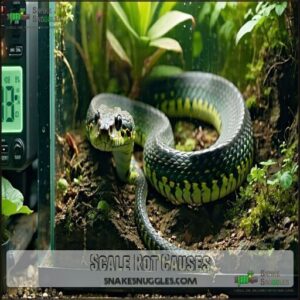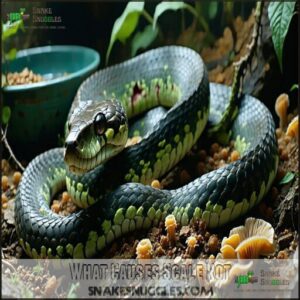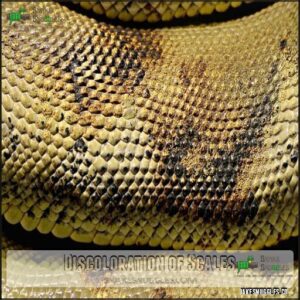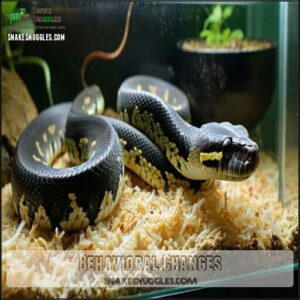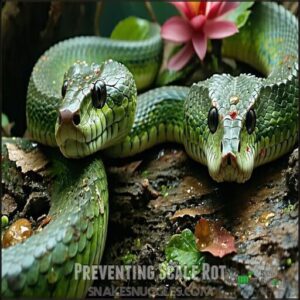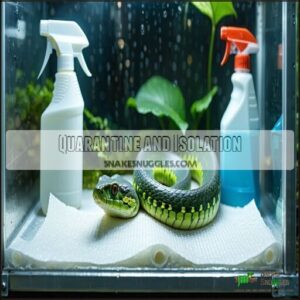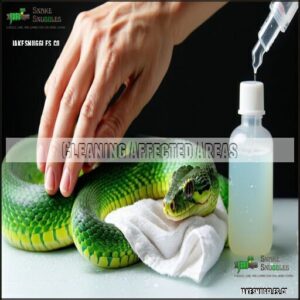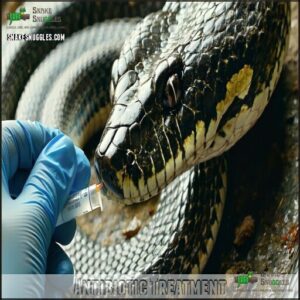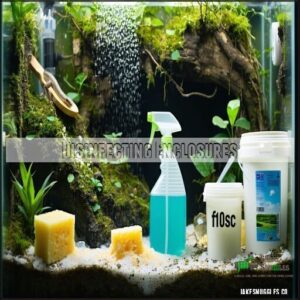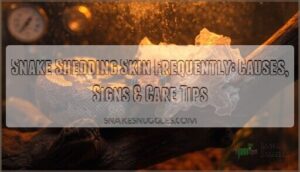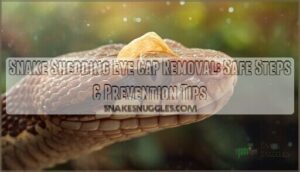This site is supported by our readers. We may earn a commission, at no cost to you, if you purchase through links.

You’ll notice redness, blisters, or discolored scales on your snake’s belly.
The main causes include too-high humidity, dirty substrate, inadequate temperature regulation, and unclean water dishes.
Snakes kept in moist bedding that isn’t changed regularly are particularly vulnerable to this condition, and injuries can also create entry points for infection.
Prevention requires maintaining proper enclosure hygiene and environmental conditions, and early detection substantially improves treatment outcomes.
Advanced cases may require veterinary intervention with specialized antibiotics and wound management protocols.
Table Of Contents
Key Takeaways
- Excessive moisture is your snake’s biggest enemy – high humidity, wet substrate, and poor ventilation create perfect conditions for the bacteria that cause scale rot.
- You’ll need to maintain proper enclosure hygiene by regularly cleaning the habitat, removing waste promptly, and replacing substrate to prevent bacterial buildup.
- Your snake’s scale rot risk increases with improper temperature regulation, as cold enclosures prevent substrate from drying out completely.
- You can identify scale rot by watching for discolored scales (brown, yellow, or black patches), fluid-filled blisters, raised scales, and behavioral changes like reduced activity or appetite.
Scale Rot Causes
Your snake’s habitat conditions directly impact its risk of scale rot, with excessive moisture, improper temperatures, dirty enclosures, and damaged scales being the primary culprits.
You’ll need to maintain proper humidity levels and cleanliness to prevent the bacterial infections that lead to this potentially fatal condition.
Elevated Humidity Levels
Moisture menaces your snake’s health when humidity levels climb too high.
Scale rot thrives in overly damp environments where bacterial growth accelerates rapidly.
Your snake’s substrate choice becomes critical—wet bedding creates the perfect breeding ground for infections.
High humidity disrupts normal shedding, leaving skin fragments that trap moisture against scales.
Without adequate ventilation, these humid conditions persist, increasing disease risk.
Even clean enclosures become dangerous when airflow is compromised.
Early detection is key, as brownish scales indicate potential scale rot.
It is crucial to address the issue promptly to prevent further complications, ensuring the health and well-being of your snake, and understanding the importance of proper ventilation.
Insufficient Temperature Regulation
While high humidity creates damp conditions, your snake’s health is equally threatened by cold enclosures.
Reptiles need proper temperature regulation to maintain their immune system. If your basking spot temperature falls below ideal levels, the substrate never dries out completely.
These constantly damp conditions create perfect breeding grounds for scale rot. Nighttime temperature drops should be moderate, as severe cooling combined with moisture virtually guarantees this dangerous snake disease.
Thermostat calibration issues or heating pad malfunctions often go unnoticed until symptoms appear, which can be related to temperature regulation and lead to damp conditions.
Filthy Enclosures
While proper temperature keeps your reptile comfortable, a filthy enclosure poses an even greater danger.
Soiled substrate and fecal buildup create perfect breeding grounds for bacteria that cause scale rot.
Waste accumulation introduces harmful pathogens directly to your snake’s sensitive underbelly.
Poor hygiene and infrequent cleaning allow bacterial growth to flourish unchecked.
Even the healthiest snake can’t defend against the microscopic threats lurking in a dirty enclosure.
Damaged Scales
Four types of scale damage create perfect entry points for bacterial infections that cause scale rot.
When your snake rubs against sharp objects in its enclosure or sustains prey bites during feeding, these abrasions break the protective barrier.
Trauma from improper handling and shedding issues also compromise scale integrity.
Regular inspection of your enclosure for potential hazards and monitoring feeding sessions helps prevent these dangerous wounds that lead to snake scale rot.
What Causes Scale Rot
Your snake’s scale rot typically results from poor husbandry conditions, including excessive moisture, improper temperature regulation, and dirty enclosures that promote bacterial growth.
Damaged scales from injuries create entry points for bacteria, while vitamin deficiencies weaken your reptile’s immune system.
Making it more susceptible to this potentially fatal condition is a result of the combination of these factors, which can lead to serious health issues for your reptile.
Living In Small Spaces
While humidity and dirty enclosures contribute to scale rot, your snake’s tight living space presents hidden dangers too.
Cramped enclosures force snakes into tight spots, creating scale damage that invites bacterial infection.
Snakes trying to squeeze through small gaps can damage their scales, creating entry points for bacteria. Even in space-optimized setups, sharp enclosure furnishings cause abrasions that lead to scale rot.
Inadequate ventilation in compact habitats worsens substrate moisture and poor hygiene conditions. Your reptile needs room to move without injuring itself.
Early symptoms can include brownish scale discoloration, so regular inspection is key to identify scale rot and ensure your snake’s health, which is crucial for preventing serious injuries.
Minimalist Design Solutions
While small spaces can limit your snake’s movement, minimalist design solutions aren’t always better.
Simple enclosures with insufficient hiding spots create stress for your reptile. Scale rot often develops when streamlined aesthetics prioritize looks over functionality.
Natural materials may harbor moisture if not properly maintained. Functional decor should include proper ventilation systems to prevent high humidity.
Clutter reduction shouldn’t mean eliminating essential environmental enrichment your snake needs for proper thermoregulation and security.
Vertical Storage Options
Vertical storage in snake enclosures can create dangerous moisture traps that cause scale rot.
While climbing structures add valuable habitat complexity and space optimization, poor ventilation in vertical setups leads to condensation buildup on walls.
This trapped humidity creates perfect conditions for bacterial growth. Your DIY projects should prioritize enclosure hygiene with proper spacing between climbing features and enclosure sides.
Remember, wood elements rot in high humidity environments unless properly sealed, creating another hidden scale rot cause.
Selecting the right enclosure guarantees proper animal welfare standards, which is crucial for the well-being of the animals and prevents scale rot.
Identifying Scale Rot
You’ll notice scale rot first as discoloration on your snake’s ventral scales, often appearing as brown, yellow, or black patches that may develop into fluid-filled blisters.
Early detection is critical, as untreated infections can spread rapidly, causing raised scales, open sores, and potentially fatal septicemia if bacteria enter the bloodstream.
Discoloration of Scales
While keeping your snake’s environment clean is essential, knowing what scale rot looks like can save your pet’s life.
The first warning sign you’ll notice is discoloration of scales.
Your snake’s normally vibrant scales may develop brown, yellow, black, or greenish-black patches, particularly on the belly. These color changes aren’t random – they signal bacterial infection beginning to take hold beneath the protective scale layer.
Blisters and Infections
Many blisters filled with yellowish or clear fluid signal an advancing scale rot infection in your snake.
These fluid-filled pockets typically form on scales that contact the substrate, indicating bacterial or fungal infection from a dirty enclosure.
As the infection severity increases, blisters rupture, creating open sores that leak pus and invite secondary infections.
The healing process requires immediate intervention to prevent systemic spread.
Raised Scales
Three key signs of scale rot include raised scales with visible blood pooling underneath.
You’ll notice scale elevation when gently touching your snake’s affected areas – scales will feel bumpy rather than smooth.
This symptom indicates advanced infection severity and underlying damage to tissue.
Tactile detection is vital; run your fingers lightly along your pet’s body to identify these abnormalities.
Snake scale rot causes significant discomfort, so prompt treatment is essential upon discovering raised scales.
Excessive moisture in the enclosure can contribute to this condition.
Behavioral Changes
A sick snake tells tales through its actions. When scale rot develops, your reptile’s behavior will change noticeably, serving as an early warning system.
- Lethargy signs appear as your snake moves less and shows reduced interest in exploration
- Appetite changes often manifest through food refusal or reduced eating
- Rubbing against surfaces increases as your pet attempts to relieve discomfort from infected scales
Watch for these behavioral changes—they’re your reptile’s way of communicating something’s wrong, which can be an early warning system, and help you identify scale rot.
Scale Rot Risk Factors
Your snake’s risk of developing scale rot increases substantially with improper habitat conditions, including excessive moisture, inadequate cleaning, and incorrect temperature regulation.
Damaged scales from injuries and nutritional deficiencies further compromise your reptile’s natural defenses against bacterial infections that cause this potentially fatal condition.
Poor Husbandry Practices
Now that you recognize the signs of scale rot, let’s look at what might be causing it.
Your snake’s habitat quality directly impacts its health, and poor hygiene in enclosures creates breeding grounds for bacteria that love attacking vulnerable scales.
Poor snake husbandry isn’t just negligence—it’s an invitation for bacteria to feast on vulnerable scales.
Incorrect temperatures prevent substrates from drying properly, while unclean conditions from uncollected waste and leftover food invite infection.
Neglecting basic snake husbandry principles puts your pet at unnecessary risk for scale rot, and it is crucial to maintain good hygiene to prevent bacteria from thriving in unclean conditions.
Inadequate Humidity Control
Beyond poor husbandry, humidity imbalance represents a major threat to your snake’s health.
Too much moisture (high humidity) prevents substrate from drying properly, creating perfect conditions for bacteria that cause scale rot.
Conversely, insufficient humidity leads to shedding difficulties and cracked scales, creating entry points for infection.
Your snake habitat requires careful monitoring with proper enclosure ventilation and appropriate substrate choice to maintain hydration without risking skin problems.
Check humidity levels daily—your reptile’s life depends on it.
Injuries and Trauma
While managing humidity is essential, physical damage to your snake’s scales creates dangerous entry points for bacteria.
Sharp objects in the enclosure, prey bites from live feeding, and rough handling can all break your reptile’s protective skin barrier.
Even shedding trauma can lead to scale rot when damaged scales become infected.
Inspect your enclosure regularly for hazards like splintered wood, sharp decorations, or substrate particles that could injure your snake’s delicate scales and lead to bacteria entry points.
Vitamin Deficiencies
While injuries create entry points for bacteria, your snake’s nutritional status can determine if its body fights off or succumbs to scale rot.
Vitamin deficiencies substantially weaken your reptile’s immune system, compromising its natural defenses.
- Vitamins A and C deficiencies directly impair skin barrier function
- Poor diet variety reduces essential mineral intake
- Feeding unhealthy or refrozen prey decreases nutritional value
- Wild snakes naturally obtain diverse nutrients from varied prey
- Scale rot often creates a dangerous cycle as sick snakes stop eating, which can be influenced by their nutritional status and immune system, leading to a weakening of their natural defenses.
Preventing Scale Rot
You’ll need to maintain proper humidity levels and clean your snake’s enclosure regularly to prevent scale rot from developing.
Securing water bowls and promptly removing waste will guarantee your reptile’s scales remain healthy and free from bacterial infections.
Proper Enclosure Maintenance
While scale rot often stems from poor hygiene and high humidity, proper enclosure maintenance is your first line of defense.
Select the right snake substrate—paper towels or reptile carpet clean easily and dry quickly. Verify that your ventilation systems allow airflow without dropping temperatures.
Position enrichment items away from water sources, establish a consistent cleaning schedule, and monitor water quality daily.
Many owners buy suitable reptile bedding for their snake’s enclosure. Remember, a dry environment is your reptile’s best protection, and reptile carpet can be a good choice.
Regular Cleaning
Now that your enclosure is set up correctly, you’ll need to adopt a consistent cleaning routine to prevent scale rot. Poor hygiene stands as a leading cause of bacterial growth that threatens your snake’s health.
Maintaining a clean habitat requires a suitable enclosure cleaner.
Here’s what your cleaning schedule should include:
- Daily spot cleaning to remove feces
- Weekly water changes to prevent contamination
- Monthly substrate replacement to eliminate bacteria buildup
- Bi-weekly disinfecting of all decor items
- Immediate cleanup of spills or food remains to ensure a clean habitat and prevent bacterial growth.
Humidity Regulation
Proper humidity regulation forms the backbone of scale rot prevention. Your snake’s species needs determine ideal humidity levels—monitor with an accurate hygrometer placed at substrate level.
Check daily readings and adjust ventilation accordingly to prevent shedding issues. Too high humidity creates bacterial breeding grounds, while too low causes incomplete shedding.
Aim for species-specific targets: ball pythons need 50-60%, while corn snakes thrive at 40-50% humidity control. A key tool is a reptile-specific hygrometer, which is essential for humidity regulation and helps in preventing shedding issues.
Secure Water Bowls
While managing humidity remains critical, your water bowl setup deserves equal attention.
Unsecured bowls can tip over, creating wet spots that foster bacterial and fungal infections—prime conditions for scale rot.
Choose the right equipment to protect your snake:
- Heavy, spill-proof bowls that resist tipping
- Non-porous bowl materials that don’t harbor bacteria
- Wide, shallow designs placed away from hiding spots
Clean bowls weekly and immediately address spills to prevent poor hygiene conditions, ensuring a healthy environment.
Treating Scale Rot
You’ll need to act quickly once you’ve identified scale rot in your snake, starting with isolation and twice-daily cleaning of affected areas using betadine solution or chlorhexidine.
Applying an antibiotic ointment after cleaning will help combat bacterial infection.
While maintaining a clean, paper-towel lined quarantine enclosure until all symptoms have resolved, is crucial for the snake’s recovery, and it is also important to remember that antibiotic ointment plays a significant role in this process.
Quarantine and Isolation
When your snake shows signs of scale rot, immediate quarantine is essential to prevent spreading bacterial or fungal infections to other reptiles.
Set up a separate quarantine enclosure with paper towel substrate that you can easily change daily.
During isolation, which typically lasts 2-4 weeks, monitor your pet’s health closely while reducing stress.
This snake quarantine period gives you time to thoroughly disinfect their primary habitat.
Cleaning Affected Areas
How you clean infected areas can make or break your snake’s recovery from scale rot.
First, gently clean affected scales twice daily using safe dilutions of antiseptic solutions like chlorhexidine or betadine (1:10 ratio).
Soak the affected area for 5 minutes, then pat dry.
Follow with antimicrobial spray to prevent re-infection. Early detection is essential for recovery.
Maintaining this cleaning frequency helps damaged scales heal properly.
Antibiotic Treatment
Once you’ve thoroughly cleaned the infected area, applying the right antibiotics becomes your next line of defense.
For the best treatment of your snake’s scale rot, follow these dosage guidelines:
- Apply topical antibiotic ointment 2-4 times daily
- Use reptile-safe products like Polysporin (avoid pain relievers)
- Follow veterinary antibiotics prescription exactly
- Maintain treatment for the full duration recommended
- Monitor for side effects or resistance concerns
Remember: consistent application is key to preventing antibiotic resistance and ensuring complete healing. It is crucial to be aware of the potential for side effects.
Disinfecting Enclosures
While antibiotics fight the infection directly, you’ll need to thoroughly disinfect your snake’s enclosure to prevent reinfection.
Once your pet is in quarantine, here’s a comparison of effective disinfection methods:
| Disinfectant | Safety Level | Effectiveness | Cleaning Frequency | Notes |
|---|---|---|---|---|
| F10SC | Very High | Excellent | Weekly | Veterinary grade, no residue |
| Chlorhexidine | High | Very Good | Bi-weekly | Gentle on surfaces |
| Diluted Bleach (5%) | Medium | Excellent | Monthly | Rinse thoroughly |
| Vinegar Solution | High | Moderate | Weekly | Natural option |
| Reptile-Safe Cleaners | High | Good | Bi-weekly | Convenient but costly |
Always replace the substrate completely when disinfecting the tank to ensure a thorough and safe environment for your pet, and remember to disinfect weekly for optimal results.
Frequently Asked Questions (FAQs)
Is scale rot contagious between different reptiles?
Like a silent invader, scale rot can spread between different reptiles.
You’ll need to isolate affected animals immediately, as the bacteria causing this infection can transfer through shared surfaces, substrate, and handling equipment.
Can scale rot heal without veterinary intervention?
Mild cases of scale rot can heal with proper home treatment.
You’ll need to maintain a clean enclosure, apply betadine soaks and antibiotic ointments.
Severe infections, however, require professional veterinary care.
How quickly can scale rot become fatal?
Just as a car crash can happen in seconds, scale rot can become fatal within days.
If untreated, it’ll progress to septicemia, especially dangerous for smaller snakes who can’t fight the infection effectively.
Does snake species affect scale rot susceptibility?
Yes, snake species do affect scale rot susceptibility.
Tropical species like ball pythons are more vulnerable due to their humidity requirements.
While desert species generally have higher resistance when kept in appropriate conditions, making them less susceptible to scale rot issues related to humidity.
Can winter brumation impact scale rot development?
During brumation, your snake’s immune system slows down, making it more vulnerable to scale rot if humidity and temperature aren’t properly managed.
Winter conditions can create moisture issues in enclosures that promote bacterial growth.
Conclusion
When reptile owner Tom discovered small blisters on his ball python’s belly, he quickly identified scale rot from what causes scale rot snakes: improper humidity levels in the enclosure.
Remember, prevention is simpler than treatment.
Monitor your snake’s environment closely, maintain appropriate humidity, clean regularly, and inspect your reptile weekly for early signs.
By understanding what causes scale rot snakes, you’ll guarantee your scaly companion enjoys peak health for years to come, and this is achieved through proper care and regular inspection.
- http://veterinarymedicinejournal.usamv.ro/pdf/vol.LVIII_4/Art12.pdf
- https://www.petmd.com/reptile/conditions/cardiovascular/c_rp_septicemia
- https://dr.lib.iastate.edu/server/api/core/bitstreams/15df7db7-a2d8-4513-a541-ac1aff2bc49a/content
- https://community.morphmarket.com/t/scale-rot-cross-contamination/50622
- https://vetericyn.com/blog/how-to-treat-scale-rot-on-reptiles/?srsltid=AfmBOoro2GWfjFOFxiKmetLXm_E-a_IqQuuCfkpqFRtiUDApDzT8toEg

